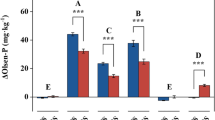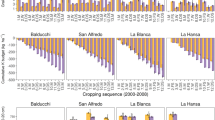Abstract
THE phosphate potential, defined by Schofield1 as ½pCa + pH2PO4, has proved useful in describing the solubility of soil phosphate. However, Schofield went further and made out a case for the phosphate potential as one parameter of phosphate availability to plants, the other being the pool of labile phosphate measured by isotopic exchange. There is little doubt that plants may get insufficient phosphate because the concentration in the soil solution is too low, but it has not been shown whether this is due to concentration per se, or to a too-low potential (using Schofield's terminology)2. The following experiment, which was carried out as part of a broader investigation, suggests an answer.
This is a preview of subscription content, access via your institution
Access options
Subscribe to this journal
Receive 51 print issues and online access
$199.00 per year
only $3.90 per issue
Buy this article
- Purchase on Springer Link
- Instant access to full article PDF
Prices may be subject to local taxes which are calculated during checkout
Similar content being viewed by others
References
Schofield, R. K., Soils and Fert., 18, 373 (1955).
Russell, E. W., Soil Conditions and Plant Growth, ninth ed. (Longman, 1961).
Hewitt, E. J., Tech. Comm. No.22 Commonwealth Bur. Hort. Plantation Crops (1952).
Aslyng, H. C., Roy. Vet. and Agric. Coll. Yearbook, Copenhagen, 1 (1954).
White, R. E., and Beckett, P. H. T., Plant and Soil, 20, 1 (1964).
Author information
Authors and Affiliations
Rights and permissions
About this article
Cite this article
WILD, A. Soluble Phosphate in Soil and Uptake by Plants. Nature 203, 326–327 (1964). https://doi.org/10.1038/203326a0
Issue Date:
DOI: https://doi.org/10.1038/203326a0
This article is cited by
-
An evaluation of plant-borne factors promoting the solubilization of alkaline rock phosphates
Plant and Soil (1983)
-
The productivity of pine plantations in relation to previous land use
Plant and Soil (1981)
-
Changes in Phosphate Potential on Re-wetting Air-dry Soil
Nature (1965)
Comments
By submitting a comment you agree to abide by our Terms and Community Guidelines. If you find something abusive or that does not comply with our terms or guidelines please flag it as inappropriate.



